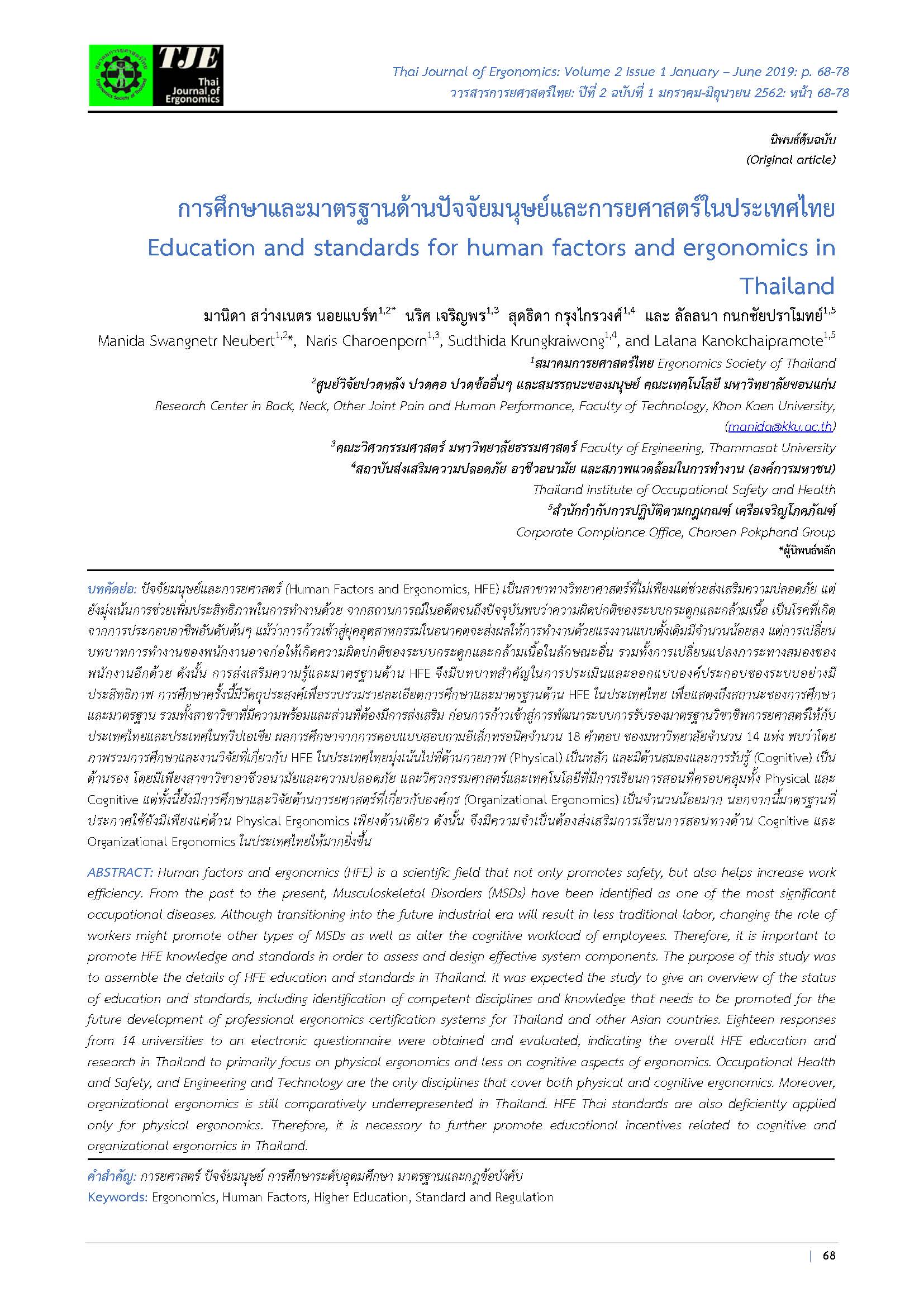Education and standards for human factors and ergonomics in Thailand
Main Article Content
Abstract
Human factors and ergonomics (HFE) is a scientific field that not only promotes safety, but also helps increase work efficiency. From the past to the present, Musculoskeletal Disorders (MSDs) have been identified as one of the most significant occupational diseases. Although transitioning into the future industrial era will result in less traditional labor, changing the role of workers might promote other types of MSDs as well as alter the cognitive workload of employees. Therefore, it is important to promote HFE knowledge and standards in order to assess and design effective system components. The purpose of this study was to assemble the details of HFE education and standards in Thailand. It was expected the study to give an overview of the status of education and standards, including identification of competent disciplines and knowledge that needs to be promoted for the future development of professional ergonomics certification systems for Thailand and other Asian countries. Eighteen responses from 14 universities to an electronic questionnaire were obtained and evaluated, indicating the overall HFE education and research in Thailand to primarily focus on physical ergonomics and less on cognitive aspects of ergonomics. Occupational Health and Safety, and Engineering and Technology are the only disciplines that cover both physical and cognitive ergonomics. Moreover, organizational ergonomics is still comparatively underrepresented in Thailand. HFE Thai standards are also deficiently applied only for physical ergonomics. Therefore, it is necessary to further promote educational incentives related to cognitive and organizational ergonomics in Thailand.
Article Details

This work is licensed under a Creative Commons Attribution-NonCommercial-NoDerivatives 4.0 International License.
References
International Ergonomics Association. Definition and domains of ergonomics [Internet]. [cited 2019 June 14]. Available from: https://www.iea.cc/whats/index.html
สำนักโรคจากการประกอบอาชีพและสิ่งแวดล้อม กรมควบคุมโรค กระทรวงสาธารณสุข. รายงานประจำปี 2561 [Internet]. สำนักพิมพ์อักษรกราฟฟิคแอนด์ดีไซน์; ธันวาคม 2561 [cited 2019 June 14]. Available from: https://ddc.moph.go.th/uploads/ckeditor/4e732ced3463d06de0ca9a15b6153677/files/ENVOCC_2561.pdf
Parasuraman R, Riley V. Humans and automation: Use, misuse, disuse and abuse. Hum Factors 1997;39:230–253.
Ranasinghe P, Perera YS, Lamabadusuriya DA, Kulatunga S, Jayawardana N, Rajapakse S, Katulanda P. Work-related complaints of arm, neck and shoulder among computer office workers in an Asian country: prevalence and validation of a risk-factor questionnaire. BMC Musculoskelet Disords. 2011;12(1):68.
International Ergonomics Association. IEA Endorsed Certification Systems for Professional Ergonomits [Internet]. [cited 2019 June 14]. Available from: https://www.iea.cc/project/12_Overview%20of%20IEA%20Endorsed%20certification%20systems.pdf
Nanthavanij S, Rurkhamet B. Ergonomics education and practice in Thailand: past, present and future. Advances in Occupational Ergonomics and Safety. 1998 Jun 1:186-9.
สำนักงานมาตรฐานผลิตภัณฑ์ (สมอ.) กระทรวงอุตสาหกรรม. รายชื่อมาตรฐาน มอก. ทั่วไป [Internet]. [cited 2019 June 24]. Available from: http://appdb.tisi.go.th/tis_dev/p3_tis/p3tis.php?data=B
สถาบันส่งเสริมความปลอดภัย อาชีวอนามัย และสภาพแวดล้อมในการทำงาน (องค์การมหาชน) (สสปท)กระทรวงแรงงาน. สื่อประชาสัมพันธ์ [Internet]. [cited 2019 June 24]. Available from: https://www.tosh.or.th/index.php/media-relations/e-book

